For normal flowering, growth and fruiting of plants, sunlight is required. In winter and autumn, there is a lack of sun, so you need to use a special light source. As such a device, you can take LED phytolamps. A florist can buy in any store, but such devices are quite expensive, and it is not always possible to find a lamp that is suitable in all parameters and characteristics. Therefore, you can make a phytolight with your own hands from an LED strip.
Features of LED backlight
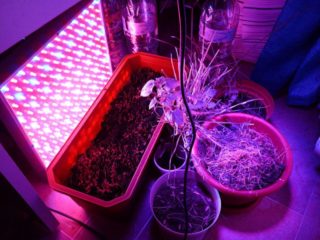
LED light sources are gradually replacing classic lamps. LEDs are used in many areas, and floriculture is one of them. Experts love such devices for their positive qualities, efficiency and practicality.
LEDs are affordable even though they are expensive. They will pay off after the first harvest. In addition, diodes consume a minimum of electricity and have a long service life. You can buy them at any electrical and lighting store.
Diode devices have the ability to adjust the spectrum. This is important, since in each period of its development, the plant requires a certain spectrum. With the help of the red and blue ranges, it is possible to create the best conditions for seedlings.
Light emitting diodes are characterized by low heating. Lamps can be installed directly over plants without fear of drying out. A homemade phytolamp can not be removed when watering - it is sealed and protected from moisture. Such devices are completely safe, since there are no harmful components in the composition.
How different spectra affect flowers
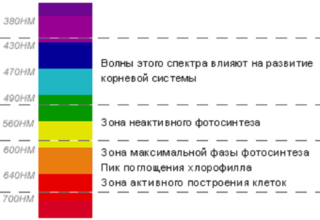
Many experiments are being carried out on the effect of artificial light on plant growth. Scientists have come to the following conclusions:
- The blue color encourages root growth and aids in strong growth.
- Red helps seed growth and flower formation.
- Yellow also performs its tasks, but already at the internal level, it is impossible to track the influence with the eye. Outwardly, it simply reflects off the leaves.
The difference between a phytolamp and a fluorescent lamp is the ability to adjust different shades for each phase of development. The optimal ratio of red and blue phyto LEDs is 3: 1 and 2: 1.
What is needed to create a phytolamp from an LED strip
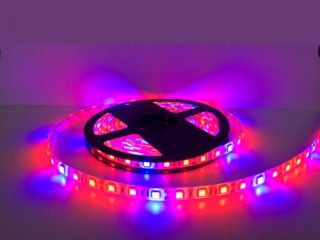
In the store, an LED phytolamp is sold at a price of 2 thousand to 15 thousand rubles. In order to save money, any person can independently create a lamp from a phyto LED strip. The assembled device can be of any size and shape. The assembly diagram is simple, even a beginner can figure it out.
To create a phytolamp with your own hands, you will need:
- red and blue LED strips;
- plywood or aluminum to create a case - it is better to take aluminum so that it additionally removes heat;
- driver;
- the wire;
- fork;
- instruments.
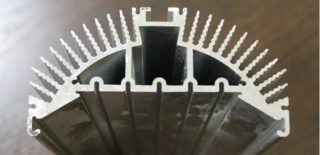
When designing phytolamps, the problem of heat removal arises. Inefficient heat dissipation leads to the fact that the LED crystal is deformed and destroyed, and this process is irreversible. The lamp will be weak and will soon burn out.
There are two types of diode cooling:
- Active.Special coolers are used to blow through the diodes. In this case, the resource of the system decreases and the risk of breakdown increases. In this case, the dimensions of the radiator will be smaller.
- Passive. Heat dissipating substrates are used. This is usually aluminum or copper.
The second option is used more often, since it requires less financial investment.
Assembly of the lamp
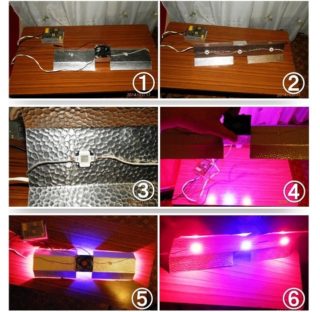
When all the necessary elements are purchased, you can begin to assemble the phytolamp with your own hands from LEDs. Work algorithm:
- Cleaning and degreasing the base.
- Installation of the cooling system.
- Cutting the required length of the tape. It is important to cut the board in the marked places so as not to damage the conductive tracks.
- Bonding the tape to a pre-designated place. Since the LED strip has an adhesive base, additional fasteners are not required.
- Connecting parts for power supply.
- Soldering of all necessary parts.
- Marking and punching holes in the housing for hanging.
- Performance check.
Before you hang a self-made phyto-lamp, you need to decide in advance where you need to put the light reflectors. This is due to the negative effects of red and blue on the eyes. The reflector reduces damage by diffusing light.
The disadvantage of this design is that both types of diodes will shine at the same time. Spot LEDs can be used instead of tape.
LED selection
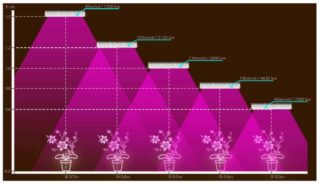
To get the desired effect, you must choose the right LEDs. Recommendations:
- To correctly calculate the number of lamps, the dimensions of the room and the height of the installation must be taken into account.
- It is necessary to comply with the requirements for growing a particular variety of plants. At each stage of development, they need a different amount of light.
- Diodes must be of high quality and have a good heat dissipation system. This guarantees the durability of the DIY LED phytolamp.
Each plant needs its own level of light:
- Plants that love shade require 1000 lux.
- Light-loving seedlings should receive 2000 lux.
- Blooming species require 3000 lux.
- Flowers sprouting in sunlight receive over 4500 lux.
The calculation is made according to the formula of the product of the area of the room by the amount of light. As a result, a certain amount of lumens is obtained, i.e. power of light radiation, which is guided when assembling the lamp.
Driver calculation and base selection
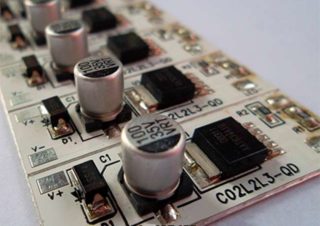
The power supply is an obligatory part of the lamp. It equalizes the output voltage and supplies the LEDs with optimal power.
The documentation for the tape indicates the value of the voltage drop at different amperage values. This value must be multiplied by the number of diodes. The optimal number of drivers is selected from the obtained parameter.
Recommendations to help with installation and connection:
- The best driver option is 50W. More powerful devices will heat up and cost more. In terms of current strength, the optimal choice of a 600 mA source.
- When calculating the driver, you should take into account the real, not the maximum power of the LEDs. It is calculated as the current of the source used multiplied by the voltage drop.
The choice of driver should be given special attention. Without this element, the normal operation of the phytolamp is impossible.
Any material can be used as the lamp surface. Phytolamps are often made of plywood, boards, but in this case it is imperative to think over the cooling system. Better to take aluminum - then the heat will be removed from the surface and the device will last longer.
You can buy an aluminum decorative strip at any hardware store. For fastening, holes are made in the corners of the base, for which you can hang the structure.
Checking the LEDs with a tester

You can determine the performance of LEDs for phytolamps using a tester. The verification algorithm is as follows:
- Installing the tester in the “open test” position.
- Touch the leads with the probe. Red is placed on the anode, black - on the cathode.
- When checking, the diodes should light up. Defective ones will not shine.
- When the polarity is reversed, the display should remain one.
Also, testing on a multitester can be carried out through the sockets for transistors. The holes on the left of the anode are placed in sockets E, the cathodes - in C. For the holes on the right, vice versa.
Common mistakes
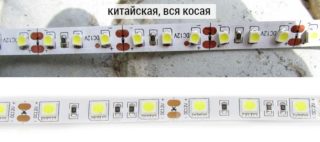
When creating a phytolamp, the following errors are most often encountered:
- Buying cheap components. Poor quality LED phyto tape will not give the desired effect to the plants, and an incorrectly selected driver will lead to poor voltage equalization and rapid lamp breakdown. The entire set of elements for assembly must be of optimum quality. To do this, it is better to take goods in a specialized store.
- Incorrect calculation of the cooling system. With poor heat dissipation, the operating time of the phytolamp is reduced.
- Poor contact between parts. Also, the influence is exerted by the leakage of the device assembled by hand.
Observance of the correct creation of the lamp will allow the device to be used for its intended purpose for many years.
Fitolamp installation
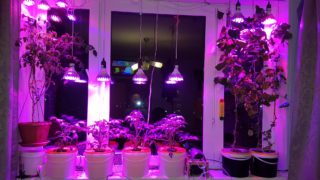
In order for the plant to receive the optimal amount of light, you need to correctly position the lamp. Growers have come up with a number of tips to help you set up your luminaire in the best possible way.
A DIY lamp can be placed directly above the seedlings. It does not heat up the environment, so you don't have to step back 10 cm.
Young seedlings love diffused light. To create it, a white sheet is hung on the wall next to the seedlings. You can also buy luminaires with a socket that points to the side. Then the light will fall from above and at an angle.
The hanging device can be attached to chains and wire loops. The lamp that is being installed can be fixed on homemade wooden supports.
The backlight time depends on the season, the type of crops, the temperature in the greenhouse or greenhouse, and other indicators.








